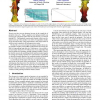Free Online Productivity Tools
i2Speak
i2Symbol
i2OCR
iTex2Img
iWeb2Print
iWeb2Shot
i2Type
iPdf2Split
iPdf2Merge
i2Bopomofo
i2Arabic
i2Style
i2Image
i2PDF
iLatex2Rtf
Sci2ools
VISUALIZATION
2005
IEEE
2005
IEEE
Streaming Meshes
Recent years have seen an immense increase in the complexity of geometric data sets. Today’s gigabyte-sized polygon models can no longer be completely loaded into the main memory of common desktop PCs. Unfortunately, current mesh formats, which were designed years ago when meshes were orders of magnitudes smaller, do not account for this. Using such formats to store large meshes is inefficient and complicates all subsequent processing. We describe a streaming format for polygon meshes that is simple enough to replace current offline mesh formats and is more suitable for representing large data sets. Furthermore, it is an ideal input and output format for I/O-efficient out-of-core algorithms that process meshes in a streaming, possibly pipelined, fashion. This paper chiefly concerns the underlying theory and the practical aspects of creating and working with this new representation. In particular, we describe desirable qualities for streaming meshes and methods for converting mes...
| Added | 25 Jun 2010 |
| Updated | 25 Jun 2010 |
| Type | Conference |
| Year | 2005 |
| Where | VISUALIZATION |
| Authors | Martin Isenburg, Peter Lindstrom |
Comments (0)

